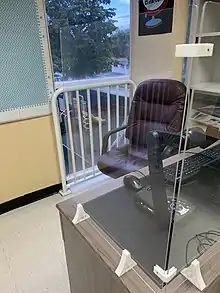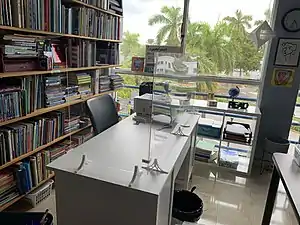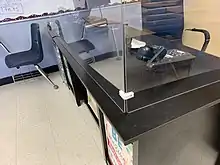Sneeze guard
A sneeze guard, sneezeguard, or cough shield is an acrylic or glass screen designed to protect food or people from the exposure to respiratory droplets, which are dispensed when coughing, sneezing or even talking. Sneeze guards have been in use in restaurants for decades. With the rise of the COVID-19 pandemic, sneeze guards have been installed in public places like offices, schools and supermarkets to reduce the risk of infection through respiratory droplets.



In February 2020, the World Health Organization advised the use of "physical barriers to reduce exposure to the COVID-19 virus, such as glass or plastic windows",[1] which is in line with the advice of the Centers for Disease Control and Prevention, which recommends to "Place a barrier (e.g. sneeze guard) between employees and customers".[2]
Styles of sneeze guards
Freestanding sneeze guards: These types of sneeze guards are made up of a clear plastic or tempered glass panel with a system designed to hold it up. The uses of a freestanding sneeze guard are endless. They may be used on reception desks, conference tables, serving tables etc... A freestanding sneeze guard can be used anywhere on a flat surface. Most freestanding sneeze guards are used on desks or raised surfaces. Some freestanding sneeze guards go from the floor to above the head and act as a clear wall. Others are designed to partition space form a seated level, like separating tables at a restaurant.
Cubicle sneeze guards: These types of sneeze guards are made of a clear plastic panel with a system designed to mount the panel onto a cubicle partition. This type of sneeze guard has risen in popularity as many businesses look to reopen safely post COVID-19 outbreak. Many companies have come out with differing versions of cubicle sneeze guards
Hanging sneeze guards: These types of sneeze guards are made up of a clear plastic panel hung from the ceiling at a desired height. This sort of sneeze guard can be customized to fit almost any purpose. These sneeze guards allow the end customer to decide where to protect. It also allows for a larger area of protection. These also tend to be the cheapest sneeze guards on the market.
Portable sneeze guards: These are the newest type of sneeze guards made available to the market in direct response to combat the 2020 COVID-19 pandemic. A Portable Sneeze Guard improves upon the traditional sneeze guard by its collapsible design enabling its transformation into an easy-to-carry form. This sort of sneeze guard conveniently transports inside a backpack, briefcase, or similar everyday carry bag. Extending the benefits of regular sneeze guards, Portable Sneeze Guards used in schools, and university campuses, in restaurants and cafes, workplaces, or practically anywhere, provide a highly mobile barrier from respiratory droplets. A Portable Sneeze Guard fills a PPE-gap, further protecting children and adults from airborne infectious disease spread from sneezing, coughing, talking, laughing, or eating.
Types of plastic
Sneeze guards are advertised under many different materials. Most companies will sell sneeze guards made of clear acrylic plastic. Acrylic is more well known under its commercial name Plexiglas is made of Poly(methyl methacrylate). This material is sold under a variety of names.[3] Other commonly used materials are Polycarbonate, a more flexible less flammable plastic, and PETG. With growing concerns over sneeze guard use, the New York State Education Department released a memo claiming certain barriers must be polycarbonate due to fire code.[4] A line in the memo reads "Note for installations where the sneeze guard is not fastened to a building element, the product would be considered a furnishing required to comply with MPS S205-13 b. Fire test criteria is required to be approved, “Items of obvious and questionable hazard avoided". For any sneeze guard in New York that does not require installation, i.e. portable sneeze guards, may be made from Plexiglas.
References
- World Health Organization (27 February 2020). "Rational use of personal protective equipment for coronavirus disease 2019 (COVID-19)" (PDF). World Health Organization.
- The Center for Disease Control and Prevention (16 April 2020). "What Airport Retail or Food Service Workers Need to Know about COVID-19". The Center for Disease Control and Prevention. Retrieved 16 April 2020.
- Doctor, Glass. "What is plexiglass and what is it made of". Glass Doctor.
- "Office of Facilities Planning, New York State Education Department May 29, 2020" (PDF).
